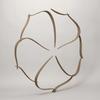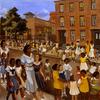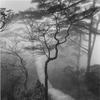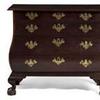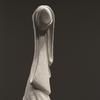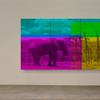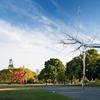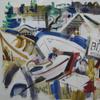Major Landscape by Moran Headlines The Russell Benefit Auction
- GREAT FALLS, Montana
- /
- January 26, 2016
The C.M. Russell Museum will offer significant works of art that have been consigned to the Live Auction on March 19, 2016, for The Russell: An Exhibition and Sale to Benefit the C.M. Russell Museum. Headlining the sale is Thomas Moran's oil painting Castle Rock, Green River, Wyoming (1907) which is projected to hammer between $3,500,000 and $4,500,000. The previous record price for The Russell Live Auction was set in 2015, when Charles M. Russell’s For Supremacy sold for $1,500,000.
Moran (1837-1926) was a British-born painter and printmaker who became one of the preeminent artists of the American West. In 1871, as a member of the Hayden Geological Survey, he recorded the glories of the area that Congress set aside in 1872 as Yellowstone National Park. Although Moran resided for most of his life in the eastern United States, the West was his inspiration and his muse. Measuring 20 by 30 inches, Castle Rock, Green River, Wyoming (1907) is an exceptional example of Moran's treatment of a subject he painted continually throughout his career.
Five significant works by C.M. Russell are offered: the previously announced Water Girl (ca. 1892) and Grizzly at Close Quarters (1901), as well as the newly consigned Indian with Bow (1900), Curley the Crow (ca.1888), and Indian on Horseback (1899). Indian with Bow (1900) is a rare example of a single-figure painting.
According to Executive Director Michael Duchemin, "It is quite unusual in that it applies a very modern technique wherein the protagonist in the painting is pointing his bow and arrow directly at the viewer, rather than at some action or animal in the scene. Using this technique, Russell appears to have intentionally broken what is referred to in theatrical circles as the 'fourth wall,' an imaginary wall at the front of the stage in a traditional three-walled box set in a proscenium theater, through which audiences see the action in the world of the play."
Russell may have completed this work as a study for a larger, more complicated painting. Art historian Brian Dippie notes that Frederic Remington and Charles Schreyvogel both used this technique, the latter most famously in his painting Breaking Through the Line. It is a technique artists learned from watching actors in Buffalo Bill’s Wild West and other similar shows, and it predates cinema. Although Russell rarely used this technique, he did employ it in two larger paintings—A Desperate Stand (1898) and The Trappers' Last Stand (1899). Indian with Bow, a 18-3/8 by 12-1/4 inch painting, is expected to sell for between $750,000 and $1,250,000. Russell painted Curley the Crow, a 29 x 22 inch oil painting, around 1888. A Crow scout in the U.S. Army during the Sioux Wars, Ashishishe (c. 1856-1923), known as Curley, was one of the few survivors on the United States’ side at the Battle of Little Bighorn. This painting is expected to sell for between $150,000 and $350,000.
Indian on Horseback is another excellent example of Russell’s early single-figure studies. This 11 by 17 inch painting was created in 1899, after Russell had married Nancy Cooper and moved to Great Falls, Montana. At that time, Russell was earning income from paintings and drawings like Indian on Horseback to illustrate national magazines, including Recreation, Western Field and Stream, and Sports Afield. This painting is expected to sell for between $125,000 and $200,000.
Measuring 14 by 20 inches, Water Girl depicts two Indian women on the banks of a stream, filling their containers with water. The woman on the right, with a baby on her back, kneels by the water, while her companion stands looking across the stream, a blanket draped over her head and shoulders. This watercolor is expected to sell for $250,000 to $325,000.
An estimate of between $700,000 and $900,000 has been established for Russell's watercolor Grizzly at Close Quarters (1901), painted during the heyday of his watercolor production. As he started work on this painting, Russell sketched the outlines of his composition in pencil directly on the paper. When studied closely, all the figures reveal some kind of drawing under the layers of wash. Compared to his early work in which the preliminary underdrawings appear fussy and labored, this painting demonstrates a more mature technique. The layers of wash and individual strokes of color in the landscape around the figures are notable for their freedom of execution and lightness of touch.
Some consignments are currently on display through March 17, 2016, at the C.M. Russell Museum. The Russell delivers a wide range of procurement opportunities for the western art collector, with each event offering an authentic experience. For the experienced collector of western art, The Russell Live Auction features significant historical works plus contemporary art from leading western artists in a competitive bidding atmosphere. This elegant evening includes a gourmet dinner and beverage service and is a must-attend event for collectors from across the country.
For more information on The Russell 2016, visit www.cmrussell.org.


